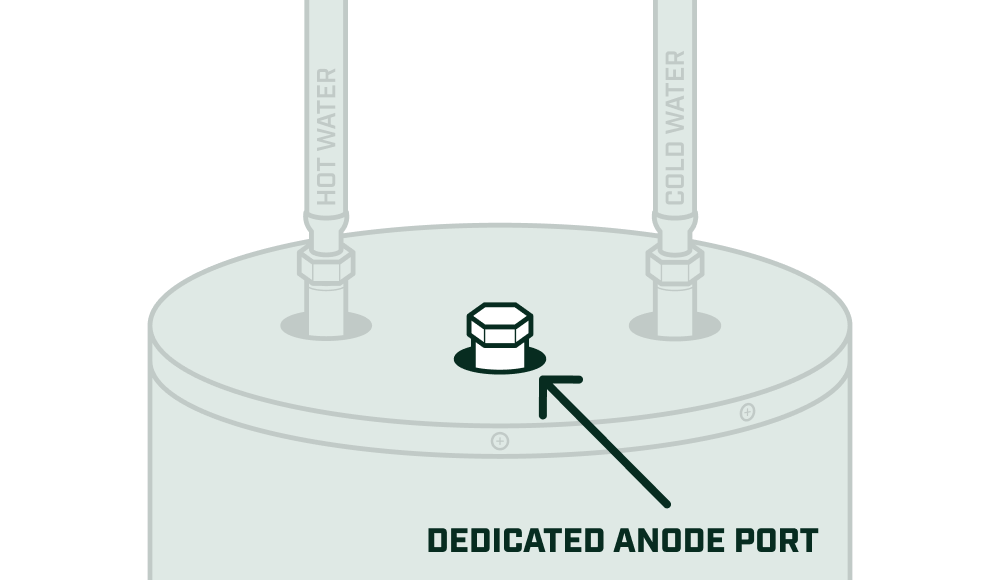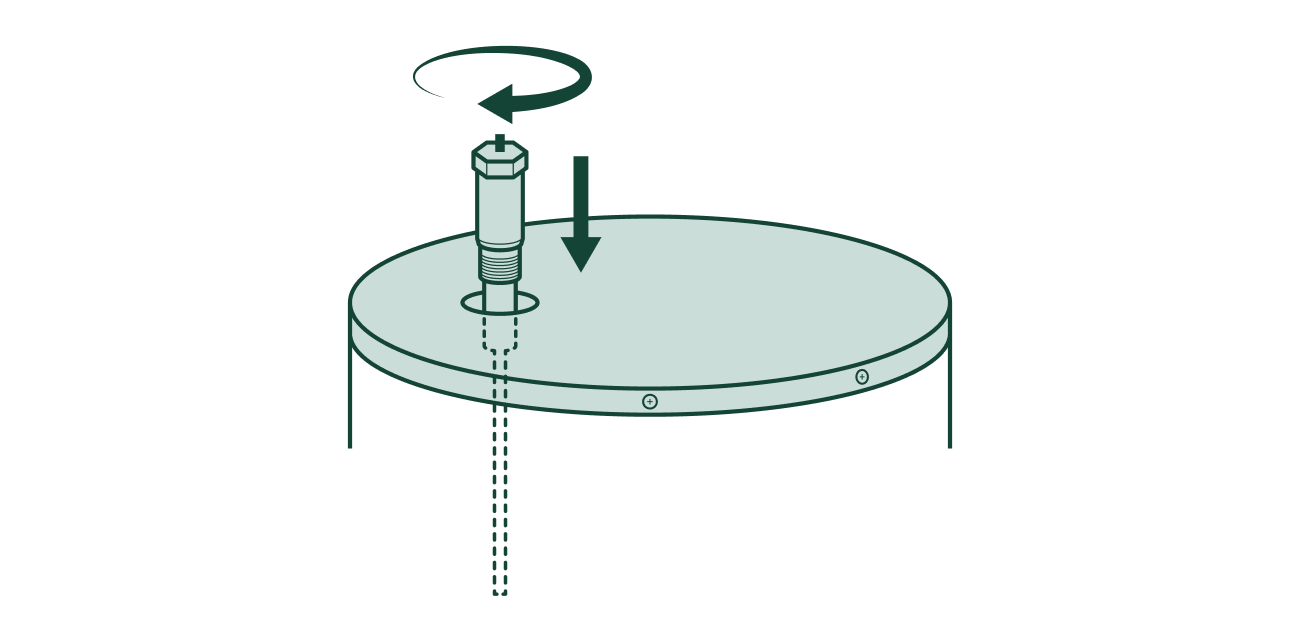Where to Find the Anode Rod on a Kenmore Water Heater and Why You Should Upgrade

Homeowners often overlook one small but important part of their Kenmore water heater: the anode rod. This piece of metal protects the inside of your water heater from rust, corrosion, and early failure.
In this guide, we will explain the Kenmore water heater anode rod location, how to check it, and why switching to a powered anode rod is a long-term solution.
Kenmore Water Heater Anode Rod Location
On most Kenmore water heaters, the anode rod is located on top of the tank. It is usually under a plastic cap that covers a hexagonal head.


Here’s how to find it:
- Look at the top of the water heater.
- Find a plastic cover near the center or side of the tank.
- Remove the cover to reveal the hex nut.
The rod is threaded into this fitting and extends into the tank.
Some Kenmore models, including specific Power Miser series units, may have two anode rods. The primary rod is on top of the tank, while the secondary rod may be built into the hot water outlet.
How to Inspect the Anode Rod
Inspecting the anode rod helps determine if it needs replacement. Follow these steps:
Step 1
Turn off the power to the heater. For gas models, switch the control to pilot. For electric models, shut off the breaker.

Step 2
Shut off the water supply. Turn the cold water valve to the off position.
Step 3
Relieve pressure. Open a hot water faucet for a few seconds.

Step 3
Drain some water. Drain about 5 gallons into a bucket to lower the water level below the top of the tank.
Step 4
Remove the rod. Use a socket wrench (often 1-1/16″) to unscrew the anode rod.

When checking the rod:
- If it is less than half of its original thickness, it should be replaced.
If the rod is coated with calcium or has exposed steel, it is no longer protecting the tank.
How Often Should You Replace the Anode Rod?
For standard sacrificial rods, Kenmore water heaters often need replacement every 3 to 5 years. However, this varies based on water quality and usage.
Hard water, water softeners, or high hot water demand can cause the rod to wear out faster.
Regular checks, every 2 to 3 years, are recommended to prevent tank damage.
Sacrificial vs. Powered Anode Rods
| Powered Anode Rod | Magnesium Anode Rod | Aluminum Anode Rod(Zn-Alloy) | |
|---|---|---|---|
| Type | Titanium (Impressed-Current) | Sacrificial | Sacrificial |
| Typical Lifespan* | 25+ yrs | 1 to 3-5 yrs | 2 to 4-6 yrs |
| Lifetime Cost* | $159.99 | $199.99 to $999.99 | $209.99 to $599.99 |
| Typical Price* | $159.99 | $39.99 | $49.99 |
| Energy savings | Reduces energy bills by $40/year by preventing sediment buildup | Increase energy use due to sediment buildup | Increase energy use due to sediment buildup |
| Anode Rod Replacement |
Never |
Frequently |
Frenquently |
| Corrosion Protection |
Stops corrosion |
Failing to replace the anode rod before it’s depleted means water heater corrosion/failure will resume; regular inspection is key |
Lose their effectiveness over time. To ensure continued protection against corrosion, timely replacement is essential |
| Sulfur smell elimination | Eliminates & Prevents sulfur smell in hot water within 24 hours, no matter the cause | Can react with certain water types, producing an unpleasant sulfur smell in hot water | Can help reduce sulfur smell in hot water |
| Sediment Build-Up | Reduces sediment accumulation | Can cause sediment buildup in the tank when the anode is deteriorated | Can cause sediment buildup in the tank when the anode is deteriorated |
| Water Quality | Best for any water chemistry (soft or hard water) | Good for any water chemistry but will deteriorate more quickly in hard water | Good for any water chemistry but will deteriorate more quickly in hard water |
| Inspect | No anode rod inspection |
Hard/Well water: yearly Soft city water: every 2 yrs |
Hard/Well water: yearly Soft city water: every 2 yrs |
| Replace | No anode replacement. Controller sounds/LED alerts after ~20 yrs |
Anode rod replacement Hard/Well water: 2 to 3 yrs Soft city water: ~5 yrs |
Anode rod replacement Hard/Well water: 4 to 6 yrs Soft city water: ~5 yrs |
| Odor Notes | Ends odor completely in less than 24 hours | Can cause sulfur smell over time | Helps reduce smell, not always fully |
Why Choose a Powered Anode Rod for Kenmore Water Heaters
Upgrading to a powered anode rod provides long-term benefits:
- Extended tank life. Protects against corrosion more effectively.
- Less maintenance. No need to replace every few years.
- Odor reduction. Helps eliminate sulfur smell.
- Compatible with all water types. Works in hard, softened, or municipal well water.
For many Kenmore water heater owners, installing a powered anode rod is the right move, extending the lifespan of the heater by several years. This long-term solution provides a sense of security and confidence in the protection of your water heater.
How to Install a Powered Anode Rod in a Kenmore Water Heater
Installing a powered anode rod is similar to replacing a sacrificial one:
Step 1
Shut off power and water.

Step 2
Relieve pressure and drain a small amount of water.

Step 3
Remove the old anode rod from the top of the tank.

Step 4
Install the powered anode rod.

Step 5
Connect the power supply according to the instructions.

Step 6
Restore water and power.
For step-by-step instructions, view our Installation Guide.
Signs It’s Time to Upgrade
You may need a new anode rod if you notice:
- Rotten egg smell from hot water
- Discolored or rusty hot water
- Tank leaks or corrosion on fittings
More than 3 years since your last anode rod replacement
The Kenmore water heater anode rod location is easy to find once you know where to look. By checking your anode rod every few years, you can prevent costly tank damage. For the best long-term protection, consider installing a powered anode rod from Corro-Protec.Explore our complete line of Water Heater Anode Rods and Powered Anode Rods to find the right fit for your Kenmore water heater.
FAQ
No, the Corro-Protec powered anode rod does not void your GE water heater warranty. In fact, GE considers powered anode rods to be maintenance parts that support the proper functioning and longevity of the tank.
In the United States, this is protected under the Magnuson-Moss Warranty Act, and in Canada, under the Canadian Competition Act. The only exception permitted by law is if a manufacturer offers an equivalent part using the same technology at no cost, which never happens.
Blog
Anode Rod Socket Size: Quick & Easy Guide
Anode rods are very important in all water heaters. They keep the water tank from rusting, so your heater can last longer. But, sacrificial anode […]
Where Is the Anode Rod on a Water Heater?
If you’ve ever wondered, “Where is the anode rod on my water heater?” you’re not alone. Homeowners often feel confused and are left searching when […]

